TERRESTRIALS
TERRESTRIALS
Patterns, Observations & Suggestions
For Fishing Terrestrials in the
United Kingdom
Prepared for the
Lincolnshire Feather-Benders & Fly Fishers
November 2009
By: Tom Travis, USA
History and Observations on Fishing Terrestrial Imitations in the
United Kingdom
Where to begin? I don’t believe that it would be wrong to state that the Art of Fishing Terrestrial Imitations for Trout and Grayling is not the most popular aspect of fly fishing in the United Kingdom.
Yet, from a historical point of view, terrestrial imitations have been in use from the earliest days of fly fishing literature. My limited research has shown me that still water anglers seem to be a little ahead of the river and stream anglers in the use of terrestrial imitations.
However, compared to what is possible, the use of terrestrials is indeed limited in the United Kingdom. I have even found an article online where the angler discussed the stomach contents of trout and concluded that terrestrial insects were unimportant as a food source for the trout and thus of little interest to the angler. Please understand that is not condemnation, simply a statement of the facts.
Terrestrials and their importance as a food source for the trout is simply a matter of education and understanding. How did the art of terrestrial fishing fall through the cracks of time in the United Kingdom? I believe I understand how this has happened and will share my conclusions with you.
At the earliest beginning of fishing, the angler used various bait to attract and catch fish. Some of these baits included minnows, worms, grubs, grasshoppers, crickets and wasps. Then along came the early beginnings of fly fishing and the anglers began to center their attention on the insect groups which hatched from the water; those being mayflies, caddis flies and midges. Those early fly anglers well understood the current fly fishing methods of deceiving trout, but they also understood why various baits were effective and thus created some of the early terrestrial fly patterns.
However, as fly fishing continued in its development, it was only natural for many to want the sport to be unique and they wanted distance from those that use bait. Remember, all of those early fly patterns were wet!
Then came the advent of the dry fly. Some angling historians claim that the creation of the dry fly is shrouded and lost in the mists of time. I think not! The idea of dry fly fishing was always right there in front of us. In 1662, Colonel Robert Venables, published The Experienced Angler. This volume is interesting as Venables was a very observant angler and shared many of his insights with the reader. He was the first to observe that:
“Trout take time some time to adjust to a new fly hatch each season.”
“Discussed upstream fishing and was in favor of it.”
“Also suggested using cork as a tying material to float the flies.”
Unless a wet is pre-soaked, when first cast upon the water it will float. How many times do you think that one of those anglers cast their newly attached fly on the water and the trout ate it before it had time to sink! Therefore, I have concluded that the next natural step was the dry fly.
In 1841, George Philip Rigney Pulman published Vade Mecum of Fly-Fishing. This began the codified theory of the dry fly. However, many anglers were still using Wet Flies with great success, even on the famed chalk streams. Then came Frederick M. Halford. Once he became converted to the dry fly and became its champion, much in fly fishing changed. Before we delve into Halford and the dry fly, let us backtrack to the early history of terrestrials in fly fishing.
Fly Fishing Terrestrials in History
The very first mention of terrestrial insects comes from the very first printed book on fly fishing. In 1496, Wynkyn de Worde published The Boke of Saint Albans. The volume contained The Treatyse of Fysshynge wyth an Angle, authored by Dame Juliana Berners. It is interesting to note that this manuscript may have been written as early at 1450. Throughout the centuries, many have challenged her authorship, but that is a subject for another time and place. In her selection of twelve flies for the season are the WASP FLY and the SHELL FLY, both of which are terrestrial imitations.
Next comes John Taverner and the publication of Certaine Experiments Concerning Fish and Fruite in 1600. Taverner writes: “And yet, I will exercise your promised patience by saying a little of the caterpillar, or the palmer-fly or worm; that by them you may guess what a work it were, in a discourse, but to run over those very many flies, worms, and little living creatures with which the sun and summer adorn and beautify the river-banks and meadows.”
Next is Izaak Walton and the publication of The Compleat Angler in 1653. Here Walton does remind us of how effective certain terrestrial baits are in fooling trout. However, in the 1676 edition of The Compleat Angler, there contained an additional section entitled Being Instructions How to Angle for A Trout or Grayling in a Clear Stream. This section was written by Charles Cotton. Cotton developed a whole range of fly patterns, including several terrestrials: the Peacock Fly (possible wet beetle), Green Grasshopper, Flesh Fly, the Little Dun Grasshopper, the White Dun (possible moth imitation), Wasp Fly, Red Ant, Black Ant, and the Harry Long Legs.
This was followed by The Art of Angling in 1747, by Richard and Charles Bowlker. They listed the Spider or Gravel Fly, Black Caterpillar Fly, Large Red Ant, Small Red Ant, Large Black Ant and Small Black Ants.
Then came the contributions of Alfred Ronalds in 1836, with the publication of The Fly Fisher Entomology. Ronalds studied both the trout and the insects and noted that terrestrial insects play a larger role in the diet of the trout during the warm months of summer than previously thought!
Remember, at this point in time, all of the fly patterns are still WET!
This now brings us back to Halford. During the late 19th Century the most visible and dominant fly fishing personality was Fredrick M. Halford. Halford was the champion of the dry fly and came to believe that no other method of fishing had merit, because the dry fly was new and enticing, because of the dominance of Halford, and because of the focus on the water insects, terrestrial fishing kind of fell through the cracks. Remember, on some club waters, even today, you may only fish upstream to visible feeding trout. There are only a few days a year when we find swarms of flying ants on the water. Even Mr. Halford’s ant pattern still looked like a mayfly.
Therefore, I have concluded, that with the advent of the dry fly, the focus on the water hatching insect, sometimes the rules that prohibit an angler from covering water blindly, and finally a lack of understanding about terrestrial insects and their relationship to the trout’s diet, has all lead to a lack of terrestrial fishing in the British Isle.
I will say the use of terrestrial patterns is far more common on still-waters. In the U. K., however I think that is still far short of what is possible. Many of the more recent British authors have given some time and consideration to terrestrial insects: John Goddard, CF Walker, Taff Price, Neil Patterson and Charles Jardine. There also a few anglers and fly tiers, who have given time to terrestrials, like Chris Watson. However, I did find one book on terrestrials entitled Trout and Terrestrials, by Lou Stevens, published in 1993. This book deals with terrestrial insects in the United Kingdom.
TERRESTRIALS AND THE TROUT
I recently read a paper that I found on the Internet, authored by a British doctor, which studied the stomach contents of numerous trout and found only a small percentage of terrestrial insects in relation to the large number of mayflies and caddis. He concluded that terrestrial insects were of small value to the fly fisher of today. Nothing is further from the truth!!!
With most fly fishers of today, we have been indoctrinated into studying the hatches of Mayflies, Caddisflies, Stone Flies and Midges. Terrestrials seldom show up in large numbers. However, trout see a steady flow of ants, beetles, houseflies, caterpillars and the like, all season long and being opportunistic feeders, they readily eat terrestrial insects when given the opportunity. In the United Kingdom, there are over 4,100 species of beetles, 1,700 species of true bugs (Cicadas, Aphids and the likes). That is just to name two categories of terrestrials. The full number of terrestrials is staggering.
Therefore, the thoughtful angler will want to become familiar with what terrestrial insects are found along the streams and ponds that are being fished. There are all kinds of resources available on the Internet for finding out what terrestrial insects call the British Isles home.
The stream angler may want to construct a couple of drift screens that can be placed along a bank and periodically check to see what a diverse bounty is being drifted to the trout. In those streams and still-waters where it is not against the rules, the angler may want to try prospecting with beetle, ant, cricket or hopper imitations.
Some call this chuck and chance fishing; it is not! With this method, the angler is covering the water with various terrestrial imitations looking for feeders of opportunity.
In closing, before moving on to the pattern section, I wish to remind those who wish to increase their use of terrestrial imitations not to forget mice and shrews. Both of these small mammals often get in the water and trout will often eat them. Some of the largest Brown Trout I have ever taken with a dry fly have come on the mouse!!!! There are a great many effective terrestrial patterns and I could list well over a hundred of my own favorites. But I won’t. I will, however, list and teach you how to tie some good basic terrestrial patterns, which will serve you well throughout the season. These patterns are not the final word; they are nothing more than stepping stones to a larger understanding of trout and the terrestrial Insect.
All of the fly patterns I list are dry flies, and are constructed mostly with dry cell fly foam. Dry cell foam will give both float-a-bility and durability to the imitation. Many of the patterns will also employ the use of various types of rubber leg material. The rubber legs will help give the imitation that “illusion” of life, which is so important for any effective imitation. Even though the patterns listed and taught in this seminar will be dry, remember that wet terrestrial imitations are also very effective. The fly fisher and fly tier who are open minded, will continue to learn and expand in both areas and become more skilled in these endeavors.
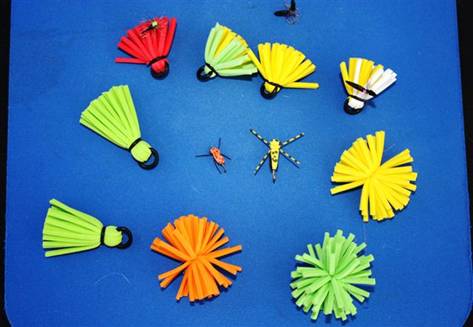
One final piece of advice: The key to angler success is the willingness to be observant to everything that may affect your angling, and I do mean everything: the weather, currents, feeding lanes, currents between you and your target, angle of presentation, vision angle, tackle being used and finally what food forms are available to the trout!
Do you know what lives along the banks and in the water of your trout stream or favorite still-water?
TERRESTRIAL PATTERNS
1. Black Foam Beetle
- Hook: Dai-Riki 300
- Sizes: 8-20
- Thread: Black 6/0 or 8/0
- Back Shell: Strip of Black Dry Cell Foam
- Head Shell: Strip of Black Dry Cell Foam
- Body: Dubbed, UV Peacock
- Legs: Black Rubber, two per side
- Indicator: Orange or Yellow Dry Cell Foam
Note: I have list a standard foam beetle pattern, which I seldom tie any longer. For the Back & Head Shell I will use bright colored dry foam that is much easier for me to see. I will color the edges of the foam so the trout sees the proper colors and light pattern from below, and I can easily see the imitation on the water. Furthermore, by using bright colored foam I can draw a cute Smiley Face on the back of the beetle, thus making it a happy bug! Yes, trout like happy bugs!!
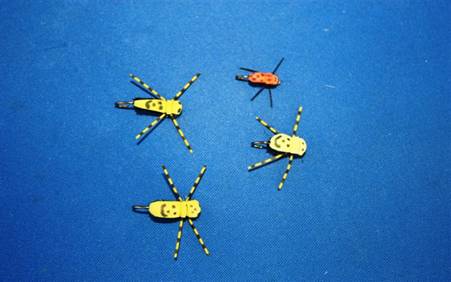
**The Happy Bugs are featured in the photographs
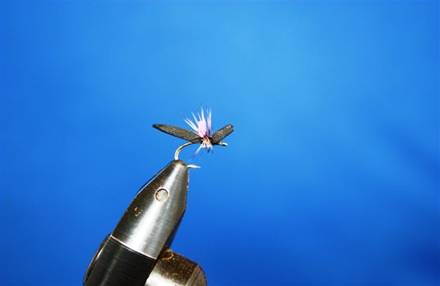
2. Black Foam Ant
- Hook: Dai-Riki 305
- Sizes: 12-20
- Thread: Black 6/0 or 8/0
- Abdomen: Black Dry Cell Foam
- Waist: Black Thread
- Hackle: Black Hackle
- Thorax: Black Dry Cell Foam
Note: The black dry cell fly foam for this imitation comes from a Foam Strike Indicator! (As pictured) A careful bit of heat from a Bic Lighter is applied and the ends are slightly tapered. This so easy and simple that it should be outlawed. I also tie these ants in red, brown and dark pink.
Yea, I know, I can here now, DARK PINK! Well, try it, trout like dark pink ants!!
3. Mega-Tan Foam Ant -
Not Photographed
- Hook: Tiemco 101
- Sizes: 14-18
- Thread: Tan 6/0 or 8/0
- Abdomen: Tan Dry Cell Foam
- Wing: Natural Dun CDC Fibers
- Legs Tan Speckled Centipede Legs
- Thorax: Tan Dry Cell Fly Foam
4. Chernobyl Ant
Not Photographed
- Hook: Dai-Riki 060
- Sizes: 6-14
- Thread: Black 6/0
- Underbody: Two strips of Mono, tied on either side of hook
- Body: Strip of Black Dry Cell Foam
- Legs: Black Rubber, two sets of two per side
- Indicator: Orange Dry Cell Foam
5. Foam Hopper:
Not Photographed
- Hook: Dai-Riki 135
- Sizes: 6-14
- Thread: Tan 6/0 and Clear Ultra Thread
- Extended Body: Strip of Yellow Dry Cell Foam
- Wing: Small clump of Elk Hair with Hopper Wing set on the top
- Thorax: Dubbed, Yellow Beaver or Scintilla
- Head: Strip of Yellow Dry Cell Foam
- Legs: Yellow Speckled Rubber Centipede Legs - Two per side
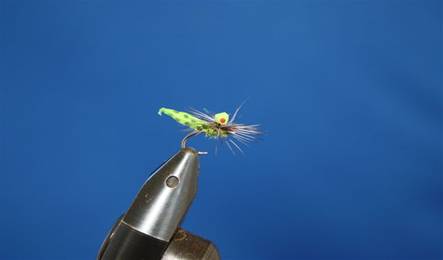
5A. Little Green Foam Hopper
- Hook: Dai-Riki 125
- Sizes: 12-16
- Thread: Olive 8/0 or 12/0
- Extended Body & Post: Chartreuse Foam
- Hackle: Grizzly, Dyed Dun, tied parachute style
- Thorax: Dubbed, Ice Dubbing Olive
Notes: The extended body is marked with dark green dots from a Sharpie Marker and the Post is marked with three red dots, for no other reason, than it looked cute! The body also comes from a Dry Foam Strike indicator. There are a great many little green hoppers in the U.K. We also have then in the U. S., little green hoppers are very effective on the Lamar River and Soda Butte Creek (Yellowstone National Park) during August and September. Here again, this style of Hopper maybe tied in several effective colors.
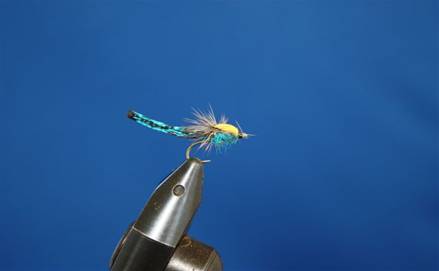
6. Parachute Blue Damsel Photographed
- Hook: Dai-Riki 125
- Sizes: 12-16
- Thread: Black 6/0
- Body Extension: Blue 1mm Rat Tail Ribbon, banded with a black marker
- Eyes: 1 pair of Black Mono eyes
- Foam Post: Strip of Blue Dry Cell Foam
- Hackle: Grizzly, tied parachute style
- Thorax: Dubbed, Scintilla Damsel Blue
Note: The fly in the photograph does not have eyes as I forgot them!
7. Foam Cricket
Not Photographed
- Hook: Dai-Riki 730
- Sizes: 8-14
- Thread: Black 6/0
- Body: Strip of Black Dry Cell Foam, wrapped
- Wing: Black Deer Hair
- Thorax: Dubbed, Blackish Brown Fur Dubbing
- Head: Strip of Black Dry Cell Foam
- Legs: Black Rubber, One set of two per side
- Indicator: Strip of bright colored Dry Cell Foam
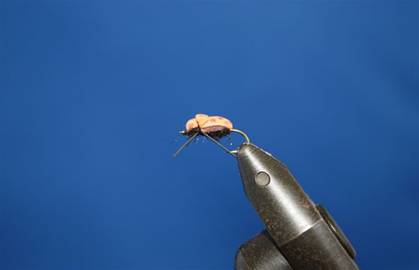
8. Lady Bug
- Hook: Dai-Riki 125
- Sizes: 14-22
- Thread: Black 8/0
- Shellback: Strip of Orange Dry Cell Foam
- Body: Dubbed, Black Fur
- Legs: Black Rubber, Mini, one set of two per side
Note: The shellback is spotted with a Black Sharpie Marker.
Thus, the terrestrial seminar is concluded.
Enjoy & Good Fishin’ & Tyin’
Tom Travis
Livingston, Montana
November 1st 2009
If you wish to further discuss terrestrial fishing or have any questions you may contact me at: Ttravis@MCN.Net
The patterns that were not photographed, well that happened because I gave them away to the kids!
